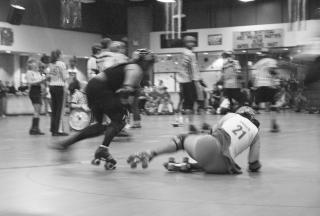The Bruise That Never Heals

Bruises are a part of roller derby — a celebrated part. It’s not uncommon for players to take pictures of their biggest, most colorful shaped bruises: bruises that go deep into your tissue, and come out in amazing blues, purples, and blacks that eventually fade to greens, browns and yellows.
A few of my teammates even had bruises that never went away – they would get worse and worse. Sometimes, these most sensitive bruises were invisible, lacking the loud color of bruises that would heal – as if the skin itself had resigned itself to injury.
When I first heard about the experience of microaggressions, I immediately related them to bruises in roller derby. Derald Wing Sue, who has studied microaggressions for a decade, defines them as “the everyday verbal, nonverbal, and environmental slights, snubs, or insults, whether intentional or unintentional, that communicate hostile, derogatory, or negative messages to target persons based solely upon their marginalized group membership.”
A person from any marginalized group can be the target of microaggression: people of color experience them from white people, women experience them from men, people who are transgender experience them from cisgender people, people who are differently abled experience them from the able-bodied. What’s common to all microaggressions is that they’re experienced as invalidating, dehumanizing, and demeaning.
- When a white woman clutches her purse as a Black or Latino man approaches her, the hidden message being sent is that the Black or Latino man, and others like him, are criminals.
- When an Asian American raised in the U.S. is complimented for speaking “good English,” the hidden message is: You are not a true American. You are a perpetual foreigner in your own country.
- When a female physician wearing a stethoscope is mistaken as a nurse, the hidden message is that women should occupy nurturing and not decision-making roles, or that women are less capable than men.
- When a person uses the term “gay” to describe something they don’t like, the hidden message is that being gay is associated with negative and undesirable characteristics.
- When the outfit worn by a TV reality-show mom is described as “classless and trashy” the hidden message is that lower-class people are tasteless and unsophisticated.
These are all microaggressions; there are many, many more. They all say, “You do not belong,” and the effect builds up over time. Someone who regularly experiences microaggressions becomes more and more aware of them. The bruise gets bigger and more sensitive until even the slightest touch is experienced as excruciatingly painful. Those who experience microaggressions suffer biologically, emotionally, cognitively and behaviorally.
If we believe in the inherent worth and dignity of each person, and if we believe in the interdependent web of all existence of which we are a part, then we must put in the effort to face our own failings.
It means learning about how we may cause harm to people, even unintentionally, and then working to make it right. It means using techniques such as “oops” and “ouch” when we have erred. It means recognizing that the impact of our words on others matters more than our intent. It means listening to the stories of others with humility and an open mind and heart. This requires constant effort, and does not come easy. And with so much other work of this nature, we will break each others hearts and fail over and over again. But, if we let it, this is what will allow us to grow.
May we choose to face the difficult truth that we are each sometimes unwitting perpetrators that cause pain to another, and may humility, love, and understanding allow us to be a part of the healing process whenever possible.
Quotes are from Microaggressions and Marginality: Manifestation, Dynamics, and Impact by Derald Wing Sue.
| Date added | |
|---|---|
| Tagged as |
#BlackLivesMatter, 1st Principle (Worth & Dignity), 2nd Principle (Justice, Equity, & Compassion), 6th Principle (World Community), Anti-Oppression, Black History / Whitney Young / James Reeb, Body, Commitment, Direct Experience, Healing, Justice, Multiculturalism, Privilege, Race/Ethnicity, Reading, Secular
|